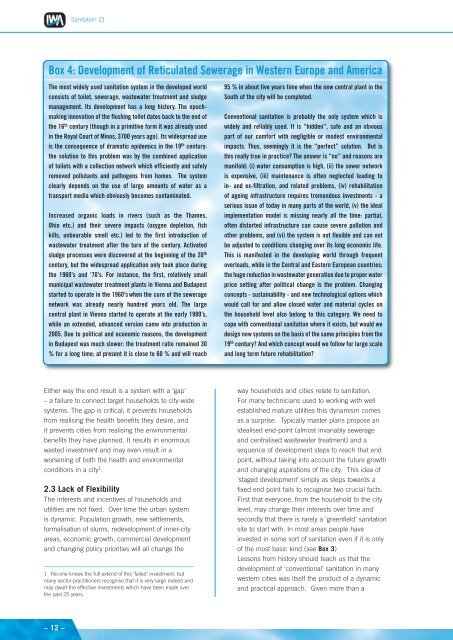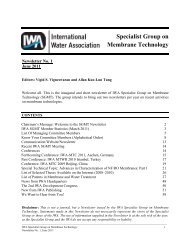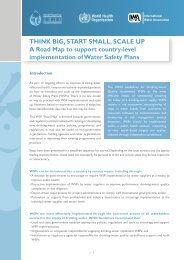Sanitation 21 planning framework - IWA
Sanitation 21 planning framework - IWA
Sanitation 21 planning framework - IWA
- No tags were found...
You also want an ePaper? Increase the reach of your titles
YUMPU automatically turns print PDFs into web optimized ePapers that Google loves.
<strong>Sanitation</strong> <strong>21</strong>Box 4: Development of Reticulated Sewerage in Western Europe and AmericaThe most widely used sanitation system in the developed worldconsists of toilet, sewerage, wastewater treatment and sludgemanagement. Its development has a long history. The epochmakinginnovation of the flushing toilet dates back to the end ofthe 16 th century (though in a primitive form it was already usedin the Royal Court of Minos, 3700 years ago). Its widespread useis the consequence of dramatic epidemics in the 19 th century:the solution to this problem was by the combined applicationof toilets with a collection network which efficiently and safelyremoved pollutants and pathogens from homes. The systemclearly depends on the use of large amounts of water as atransport media which obviously becomes contaminated.Increased organic loads in rivers (such as the Thames,Ohio etc.) and their severe impacts (oxygen depletion, fishkills, unbearable smell etc.) led to the first introduction ofwastewater treatment after the turn of the century. Activatedsludge processes were discovered at the beginning of the 20 thcentury, but the widespread application only took place duringthe 1960’s and ‘70’s. For instance, the first, relatively smallmunicipal wastewater treatment plants in Vienna and Budapeststarted to operate in the 1960’s when the core of the seweragenetwork was already nearly hundred years old. The largecentral plant in Vienna started to operate at the early 1980’s,while an extended, advanced version came into production in2005. Due to political and economic reasons, the developmentin Budapest was much slower: the treatment ratio remained 30% for a long time; at present it is close to 60 % and will reach95 % in about five years time when the new central plant in theSouth of the city will be completed.Conventional sanitation is probably the only system which iswidely and reliably used. It is “hidden”, safe and an obviouspart of our comfort with negligible or modest environmentalimpacts. Thus, seemingly it is the “perfect” solution. But isthis really true in practice? The answer is “no” and reasons aremanifold: (i) water consumption is high, (ii) the sewer networkis expensive, (iii) maintenance is often neglected leading toin- and ex-filtration, and related problems, (iv) rehabilitationof ageing infrastructure requires tremendous investments - aserious issue of today in many parts of the world, (v) the idealimplementation model is missing nearly all the time: partial,often distorted infrastructure can cause severe pollution andother problems, and (vi) the system is not flexible and can notbe adjusted to conditions changing over its long economic life.This is manifested in the developing world through frequentoverloads, while in the Central and Eastern European countries;the huge reduction in wastewater generation due to proper waterprice setting after political change is the problem. Changingconcepts - sustainability - and new technological options whichwould call for and allow closed water and material cycles onthe household level also belong to this category. We need tocope with conventional sanitation where it exists, but would wedesign new systems on the basis of the same principles from the19 th century? And which concept would we follow for large scaleand long term future rehabilitation?Either way the end result is a system with a ‘gap’– a failure to connect target households to city-widesystems. The gap is critical; it prevents householdsfrom realising the health benefits they desire, andit prevents cities from realising the environmentalbenefits they have planned. It results in enormouswasted investment and may even result in aworsening of both the health and environmentalconditions in a city .2.3 Lack of FlexibilityThe interests and incentives of households andutilities are not fixed. Over time the urban systemis dynamic. Population growth, new settlements,formalisation of slums, redevelopment of inner-cityareas, economic growth, commercial developmentand changing policy priorities will all change the No-one knows the full extend of this ‘failed’ investment, butmany sector practitioners recognise that it is very large indeed andmay dwarf the effective investments which have been made overthe past 25 years.way households and cities relate to sanitation.For many technicians used to working with wellestablished mature utilities this dynamism comesas a surprise. Typically master plans propose anidealised end-point (almost invariably sewerageand centralised wastewater treatment) and asequence of development steps to reach that endpoint, without taking into account the future growthand changing aspirations of the city. This idea of‘staged development’ simply as steps towards afixed end point fails to recognise two crucial facts.First that everyone, from the household to the citylevel, may change their interests over time andsecondly that there is rarely a ‘greenfield’ sanitationsite to start with. In most areas people haveinvested in some sort of sanitation even if it is onlyof the most basic kind (see Box 3)Lessons from history should teach us that thedevelopment of ‘conventional’ sanitation in manywestern cities was itself the product of a dynamicand practical approach. Given more than a– 12 –
















